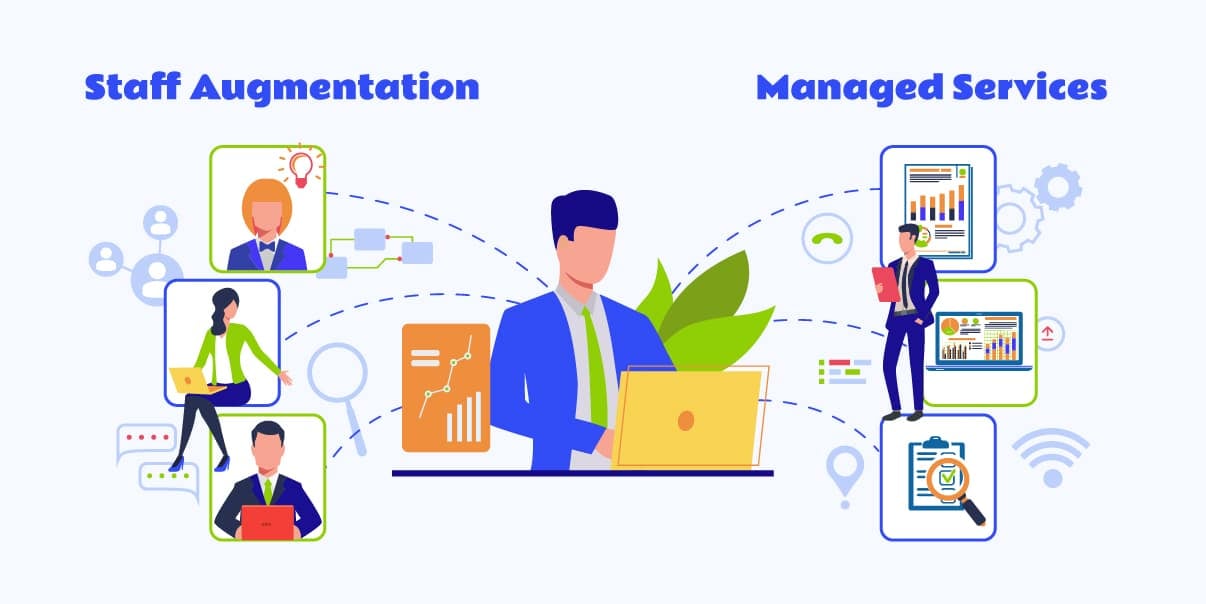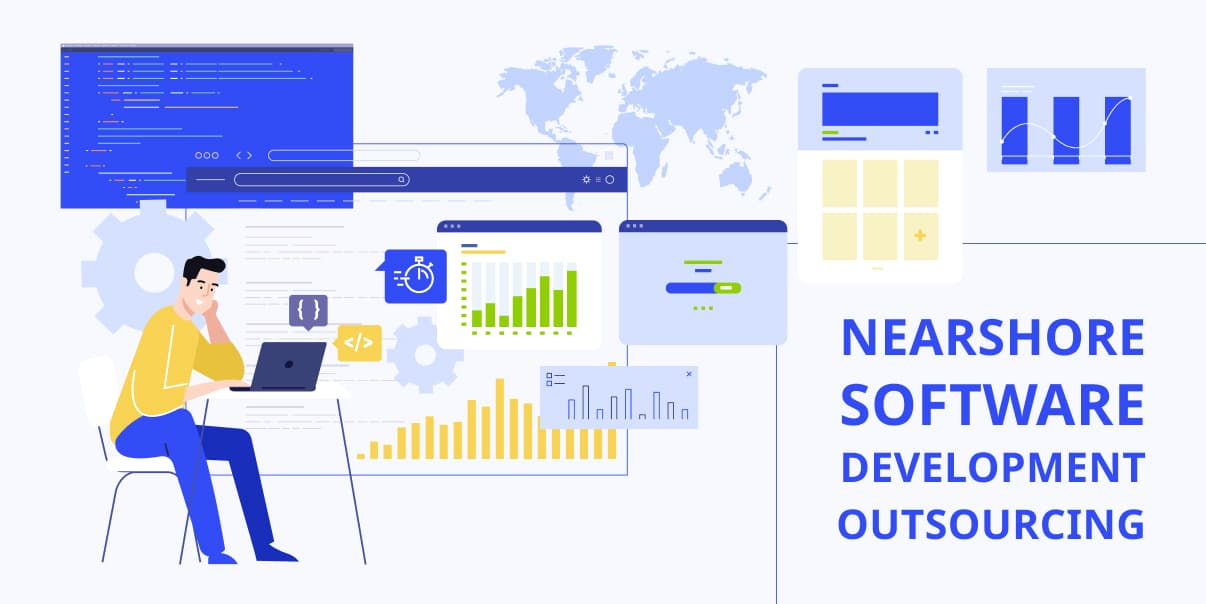Staff Augmentation vs. Managed Services: A Comprehensive Comparison

Staying competitive in the tech industry is vital. Businesses must keep up with the latest tech tools and trends in this fast-paced world. And one of the most common technologies you need is IT outsourcing solutions. If you need these services, rely on managed services and staff augmentation. These two models offer various advantages, depending on your business needs.
When you want to outsource aspects of IT, it can take time to decide which route is the best for your business. IT staff augmentation vs. managed services may be a tough comparison.
This blog post will compare these two popular approaches for finding resources. Keep reading to make an informed decision on which works best for your organization.
Let’s start with staff augmentation.
What Is Staff Augmentation?
![What Is Staff Augmentation? [Infographics]](https://www.bitstudios.com/wp-content/uploads/2023/05/Staff-Augmentation-Vs-Managed-Services.jpeg)
Staff augmentation is a way to improve technology operations and outsource some IT tasks. It can help your business by saving money, increasing productivity, and helping you use the right expertise. When you use staff augmentation, you hire a service provider to take care of specific, short-term tasks. You don’t need to worry about managing the service provider because they are independent contractors.
You and the service provider agree on a service level agreement (SLA) outlining expectations. This agreement will include when the augmented staff should complete the task. It should also include what service the staff augmentation provider should provide.
Types of Staff Augmentation
There are different types of staff augmentation. Businesses have the freedom to choose which to use depending on their needs. We listed the different types to help you decide which works best for your business.
Short-term
This type is a good choice if you need dedicated staff for projects of short duration. You can select the services you need from your preferred staff augmentation provider. Short-term staff augmentation saves on costs by hiring staff only for the time required for a particular project.
Long-term
Long-term staff augmentation is ideal when the in-house team needs additional members on a more permanent basis. It can provide a steady stream of permanent employees to help businesses save costs in recruitment and onboarding. You can have additional staff without having to invest in long-term contracts.
Commodity
Commodity staff augmentation is popular for businesses looking to supplement their in-house team. It provides organizations with access to many types of staff, usually contractual. Commodity staff augmentation fills in any gaps where needed. It can range from senior-level staff members like C-suite executives down to entry-level. This strategy allows companies to stay agile by ensuring they have available staff resources.
Skill-based
Skill-based staff augmentation model offers a cost-effective way to expand your workforce. It can provide high-level resources that may not be available in your organization. It offers employee benefits to start as soon as possible with less paperwork than traditional hiring. The skill-based model also gives businesses access to experts with specialized knowledge.
Highly-skilled
Highly-skilled staff augmentation allows companies to assemble expert teams quickly. These specialized teams are often experts who can bring expert skillsets and insights to a project. By bringing in experienced professionals, companies can speed up their development cycle. The advantages of this type include faster time-to-market processes. Plus, it improves the accuracy and quality of deliverables.
Benefits of Staff Augmentation
Staff augmentation is an effective way to optimize your technology operations. Here are the benefits you can get from this outsourcing model.
Cost Savings
Staff augmentation can help organizations save time and money. It also allows them to use specialized professionals with the right expertise.
Scalability
With staff augmentation, businesses can quickly scale up or down depending on their current needs and workloads. They can do it without having to hire additional personnel or resources.
Access to Expertise
Staff augmentation gives businesses access to experts with the skills needed for a particular project. It saves time and money getting new employees up to speed on specific tasks or processes.
Increased Flexibility & Productivity
Organizations can assign complex tasks or projects to an expert with the help of staff augmentation firms. It increases productivity, as they have fewer distractions from other duties.
Resource Leverage
Staff augmentation helps businesses leverage the resources of external partners. They can access a broader range of expertise and services without building their in-house team.
Speed
Staff augmentation is generally faster for short-term needs. It is an excellent choice for services such as bug fixes and minor feature implementation.
Control
With staff augmentation, businesses have complete control over their staff selection and timeline. It allows you to meet tight deadlines with minimum stress by getting the most qualified staff for the job.
Drawbacks of the Staff Augmentation Model
Staff Augmentation is a popular solution for companies who want to add human resources without the hassles of recruiting. However, there are some drawbacks that you need to consider before committing to this strategy.
Increased Overhead Costs
Staff augmentation is an appealing cost-saving measure but may also increase overhead costs. Although the company does not need to pay for employee benefits and training, there are still associated costs. Hiring staff from a third-party vendor can be expensive, often with additional fees.
Limited Access to Talent Pool
Staff augmentation limits access to a talent pool since firms may only hire from a specific list of candidates. It means businesses don’t have complete control over whom they can employ.
Lack of Flexibility
With staff augmentation, businesses need more flexibility in hiring practices. After completing the project, the augmented employees must either be let go or shifted to a different department or task. Deciding makes it difficult for businesses to pivot quickly and remain agile in their operations.
Security Risks
There is a risk of security breaches when your operations involve outside personnel. You must implement proper protocols to ensure that all staff members adhere to rules regarding data management.
Potential Knowledge Loss
Working with a staff augmentation partner increases your organization’s resources and knowledge. However, there is a risk that sharing too much information with a staff augmentation firm can eventually lead to knowledge loss. It happens when the partner gains an in-depth understanding of your business operations. They can take the work away from you instead of helping you complete tasks.
What Are Managed Services?
The managed service model is when a company operates another company’s technology. They do things like update software and fix any problems. They also help to keep the technology running smoothly and prevent any outages or issues. Businesses can use this model for cloud computing, disaster recovery, networking, and security solutions. Companies can reduce the costs associated with these areas by using a managed IT services provider.
Types of Managed Services
There are many different managed services models, each with benefits and drawbacks. Let’s explore the various managed service types and how you can use them in different scenarios.
Networking and Infrastructure
In this model, a service provider assumes control over operating the computers and networks for another company. They help to keep the technology running smoothly. They update software, fix problems, prevent outages, and help with data security.
Security Management
Security Management is when a company helps to keep your information safe. They allow you to ensure that no one can access your data without permission. Their job involves encrypting data, establishing user access rules, and using authentication methods. Additionally, they help ensure your systems are up-to-date with the latest security patches. They will also help you create a plan for responding to cyber threats or data breaches, should they occur.
Communication Services
Communication services help people communicate with each other. It could include phones, emails, or video chat. With communication services, you can provide a better customer experience. Plus, you can improve employee collaboration.
Many businesses use communication services to stay connected with customers and employees. It helps keep everyone in the loop about critical updates.
Software as a Service
Software as a Service is a managed service model that lets you access software over the internet. This model is helpful for companies that don’t have expertise in software development or lack IT resources. It helps streamline processes and facilitate collaboration among employees. It allows you to deploy apps without worrying about hardware, storage, or server maintenance.
Data Analytics
Data Analytics is a service that looks at numbers and information to help solve problems. It helps people make decisions by looking at all the data available. Data analytics helps businesses understand trends, analyze data, and more. It can help them to identify potential opportunities or risks in the market. Data analysts use specialized software to analyze data and extract useful information.
Support Services
Support Services help people with something they need. For example, when you need tech support for your computer, you can call a Support Service for help. They will troubleshoot the issue and help walk you through how to fix it.
Benefits of Managed Services Model
The managed services model is becoming popular as businesses seek to reduce costs and improve efficiency. Outsourcing IT services allows businesses to access the latest technology and expertise. Here are some key benefits of using managed IT services for your business.
Cost Savings
Managed IT services model can help businesses save money. It reduces the need for in-house IT staff and equipment costs associated with managing a network.
Increased Efficiency
A managed services provider gives better, faster solutions than a company’s in-house team. They have specialized knowledge and experience with similar technology challenges.
Improved Security
With managed services, companies can stay ahead of any potential security threats. They also have access to data backup/disaster recovery tools if needed.
Reduced Downtime
Managed IT services model allows businesses to fix issues before they become big problems. It helps reduce downtime and disruption of operations or customer service levels.
Predictable IT Budgeting
Through managed services, companies no longer have to worry about unexpected expenses. It gives them more control over spending and peace of mind that their systems will remain up-to-date without breaking the bank.
Access to Expert Resources
Software developers from managed IT service providers are experts at their craft. They can provide the guidance businesses need to stay up-to-date on current technology trends. It helps them maintain a competitive advantage.
Increased Scalability
With managed services, companies can scale their IT operations as their business grows and needs change. It helps them to stay agile.
Compliance Support
Managed service providers maintain compliance with industry standards and regulations. They provide ongoing monitoring and support to ensure they meet the required guidelines.
Automation
Managed service providers offer automation capabilities. They streamline processes, allowing companies to become more efficient and productive.
Comprehensive Solutions
A managed services company offers a comprehensive solution for businesses to address their IT needs. It ranges from security and compliance to network monitoring, maintenance, and support. Managed services allow them to focus on what they do best – running their business.
Drawbacks of Managed Services
Managed services have numerous benefits for businesses but also some drawbacks. Companies must weigh the pros and cons before deciding whether or not this model is right for them.
Lack of Control
When you outsource IT services, you lose control of the process and rely on your managed service provider. Lack of control can be daunting for some companies as they may not feel they have enough control of the process.
Service Outages
A managed service provider is not immune to outages. When an outage occurs, your business may experience a loss of productivity or other issues. It can negatively impact your operations.
Increased Costs Over Time
Using the managed services model can initially save businesses time and money. However, the financial costs often rise over time without providing a return on investment. It is essential to consider long-term costs when deciding whether or not managed services are right for your organization.
Vendor Lock-In
Businesses may be limited to specific vendors when using managed IT service providers. Contractual agreements could affect their ability to switch providers.
Security Risks
Data stored on remote servers is more likely to be exposed to outside threats from hackers or malware. Companies must maintain security protocols constantly to ensure data is kept safe.
Lack of Flexibility
Collaborating with a managed IT service provider is not ideal for organizations looking to stay agile. As a result, companies must choose between getting specialized support or customizing their own.
Slow Response Times
Response times from managed IT service providers can be slower than the in-house staff. Businesses funnel through multiple points before reaching their destination, thus the delayed responses.
What’s the Better Choice for Your Business?
Managed services and staff augmentation are viable options for IT outsourcing. It offers comprehensive solutions and includes maintenance, monitoring, support, security, and networking solutions. On the other hand, staff augmentation focuses on providing additional resources to your IT department. Both of them have cost-effectiveness as a benefit, but with different approaches.
When deciding which option is best for your IT organization, consider the following:
- Size and scope of your operations
- Budget constraints
- Regulatory requirements
- Level of control you need over your IT infrastructure.
The staff augmentation model is an excellent fit for businesses that need to stay flexible but don’t want to invest in long-term contracts. Managed services are best for organizations that require a more comprehensive approach and have the budget to invest.
No matter which option you choose, research a provider that meets all your needs. With the proper service provider, you can stay ahead of the competition and take advantage of the latest trends.
Conclusion
Staff augmentation and managed services are great options for businesses looking to do more with less staffing. But each option has its advantages and disadvantages. Ultimately, the best choice for your business will depend on your specific needs and goals.
Suppose you need help deciding which direction to go in. In that case, BIT Studios offers staff augmentation services to help you get started. Call us today to learn how we can help you grow your business.
We’re BIT Studios!
At BIT Studios we specialize in designing, building, shipping, and scaling beautiful, usable products with blazing-fast efficiency



